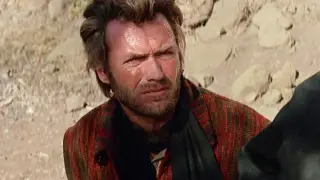We may receive a commission on purchases made from links.
In the vast, sun-scorched landscapes of Mexico, Don Siegel's 1970 Western masterpiece "Two Mules for Sister Sara" unfolds. At its heart lies Shirley MacLaine as Sister Sara, a nun whose life becomes entangled in the turmoil of the French Intervention in Mexico. Her journey across the unforgiving deserts is not merely one of survival but also one of defiance, as she supports the Juaristas—those loyal to President Benito Juárez—and evades the ever-present threat of French soldiers.
Her path crosses with Hogan (Clint Eastwood), a seasoned former Union soldier haunted by his past battles in the U.S. Civil War. Together, they form an unlikely bond forged through shared moments of humor and danger. Sister Sara’s unorthodox nature—her penchant for cussing and her love for whiskey—sets her apart from the conventional image of a nun. This connection deepens as they embark on daring escapades, including the audacious act of bombing a train together. In a drunken moment of honesty, Hogan admits his admiration for Sara, revealing layers of vulnerability beneath his rugged exterior.
The film was meticulously crafted over 65 days amidst the rugged terrains of Mexico. Director Don Siegel recounted his struggles with producer Marty Rackin in Judith M. Kass’ 1975 biography, "Hollywood Professionals: Tod Browning, Don Siegel." Aware that Rackin intended to re-edit the film, Siegel collaborated closely with cinematographer Gabriel Figueroa to ensure efficiency in shooting, hoping to preserve the integrity of their vision.
Clint Eastwood reminisced about the production in "Clint Eastwood: Interviews," edited by Robert E. Kapsis and Kathie Coblentz. He spoke fondly of his intended co-star, Elizabeth Taylor, who had initially expressed interest in playing Sister Sara. During a visit to the set of "Where Eagles Dare," where Eastwood worked alongside Taylor’s husband Richard Burton, she handed him the script, sparking discussions of collaboration. Universal Pictures eagerly embraced the idea, yet Taylor imposed a unique condition: she would only film near wherever Burton was working at the time. Thus, the production relocated to the deserts outside San Felipe, Mexico, aligning perfectly with the film's setting.
However, challenges arose during production. While filming coincided with the impending release of Universal’s musical "Sweet Charity," starring MacLaine, the studio opted to cast her opposite Eastwood instead of Taylor, capitalizing on her anticipated success. As Eastwood reflected, casting MacLaine stretched the imagination since Sister Sara was originally envisioned as a Mexican character. Ideally, Sofia Loren or even a Mexican actress might have brought authenticity to the role.
Despite these complexities, "Two Mules for Sister Sara" remains a beloved yet underrated gem in Eastwood’s illustrious career. Though it doesn't rank among his most celebrated works, it resonates deeply with audiences who appreciate its blend of adventure, wit, and heartfelt camaraderie.
An intriguing footnote: In 1970, Elizabeth Taylor starred alongside Warren Beatty in "The Only Game in Town." Fatefully, her role in "Two Mules for Sister Sara" was assumed by none other than her real-life sister, Shirley MacLaine.
"[Elizabeth Taylor and I] wanted to do it together, and the studio approved of the combination," Eastwood recalled. "But she was navigating a delicate situation where she refused to work unless it aligned with Richard’s schedule. We planned to shoot in Mexico while Richard worked on another project there. However, additional complications emerged. The studio leaned toward Shirley MacLaine, buoyed by high expectations for 'Sweet Charity.' It required some adjustments in writing, and casting Shirley tested the limits of believability."




